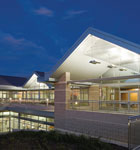 Wulff Architects’s original philosophy has created a dynamic culture that hasn’t bowed to challenging times. Al Wulff (right) founded the firm 20 years ago with the goal of forming a harmonious group, one that would practice consensus decision-making and personal responsibility. Now, with 11 employees, Wulff Architects has six principals, all of whom are personally invested in the business and the ownership of their Philadelphia office. The firm relies on each owner’s unique specialty, from housing to LEED consulting, to help it succeed during what is being called “the new normal.” Here, Wulff shares key business strategies that continue to bring the firm success.
Wulff Architects’s original philosophy has created a dynamic culture that hasn’t bowed to challenging times. Al Wulff (right) founded the firm 20 years ago with the goal of forming a harmonious group, one that would practice consensus decision-making and personal responsibility. Now, with 11 employees, Wulff Architects has six principals, all of whom are personally invested in the business and the ownership of their Philadelphia office. The firm relies on each owner’s unique specialty, from housing to LEED consulting, to help it succeed during what is being called “the new normal.” Here, Wulff shares key business strategies that continue to bring the firm success.
Identify strong markets. As the economy shifted, we realized we had to diversify and move into new markets. One of the areas which greatly helped us was housing. In the past six years, we’ve completed the design of over 1,000 urban lofts and apartment units. This led us to our work with assisted-living facilities and to our success with the Diamond Green project, the largest modular student-housing project in Philadelphia. We also expanded our lab and medical work with the help of our principals David Schoenhard, who took on the Colorcon project, and Roberta Devlin, who was responsible for doctor’s suites. Medical and housing are very hot right now, so it is a matter of identifying these strong markets and finding our way into them.
Follow clients. Just as we identified strong markets, we also identified strong clients and grew with them, geographically and otherwise. One of our principals, Dave Schmauk, really spearheaded our growth into housing, and one of the ways he did that was by following the lead of key clients who were breaking into new markets. The Diamond Green project was our seventh project with Orens Brothers Real Estate. They were originally building condos, but when the market shifted, they got into apartments. We went with them, and it really worked out for all of us.
Choose wisely. During the rough times, we also learned how to pick clients, opportunities, and proposals carefully. Our controller, Susan Tarasiewicz, has been central to this effort. Previously, we worked with clients through tough times on problem projects. In 2008, we became more selective, investing our resources with excellent existing clients and new ones who appreciate the quality of our designs. We have also focused on strengthening our alliances with our sub-consultants and engineers, who can be an excellent source of work.
Make use of talent. I think the way things are is “the new normal” for the next three or four years. We have this very sharply defined core group in our firm whose talents we rely on, but we’re also making use of the talent of select individuals. We work with excellent architects that round out much of the work [that] we do, and the economy has made it clear that there are so many gifted people available to consult. There’s new fluidity in the job market, and those who are talented will do well no matter what’s going on in the economy. Those are the capable, resilient people we want to work with.

